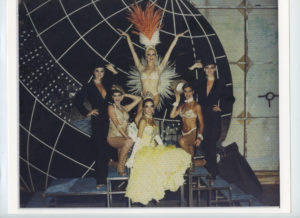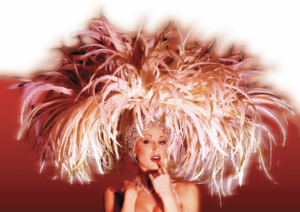The Showgirl: A Las Vegas Story
Winter 2022-2023
The history and legacy of the city’s proudest performers.
BY HEATHER CAPUTO
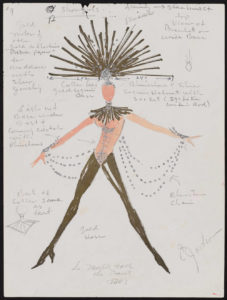
The Las Vegas showgirl was beautiful, majestic, and larger than life. In full feathers and heels, a showgirl could measure 10 feet tall. She exuded poise and panache, and her revealing costume was bedecked in glimmering Parisian crystals and expensive fur. She was a city icon who helped Las Vegas become the Entertainment Capital of the World.The showgirl is a distant memory for most, but there is hope that she will one day return to the stage.
PARISIAN IMPORTS
The modern showgirl wasn’t born in Las Vegas, but she was perfected there. The first costumes, productions, and even performers were imported from France. The first show in Las Vegas, “Lido de Paris,” opened at the Stardust Hotel in 1958. In 1959, the “Folies Bergere” followed at the Tropicana.
The stage shows offered the ultimate experience in modern entertainment: live orchestras, song and dance numbers, novelty acts, and, of course, topless showgirls.
“These shows had a special kind of allure that promised the glitz and glamour that only Las Vegas could offer. They (the shows) became ingrained as part of the Las Vegas experience,” explains Su Kim Chung, archive curator at UNLV.
The tremendous success of the first productions inspired more hotels along The Strip to start their own. Millions of tourists came to see the shows and stayed to gamble. Las Vegas’ economy thrived.
For decades, the stage spectaculars ruled Las Vegas’ entertainment scene. The showgirl became much more than a topless talent: She was proudly promoted as the symbol of her city.
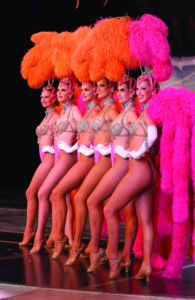
AN ERA ENDS
To maintain its status as an entertainment capital, Las Vegas has always been open to change. Little is permanent there. Buildings are imploded, and new ones rise in their place. Entertainment offerings have evolved and adapted with the times. But for decades, the original French showgirl productions survived.
It wasn’t until the 1990s that the classic stage shows floundered—the winds of change had finally battered the historic productions. There were several reasons for this. The city had become more corporatized, and the hotels no longer supported the extremely costly shows. The productions had also become outdated and antiquated, and the draw of a topless dancers was no longer attractive to audiences.
The showgirl productions closed one by one. “Casino de Paris” was discontinued in 1981, “Lido de Paris” in 1991, and “Folies Bergere” in 2009. “Jubilee!”, which ran for 34 years, was the last showgirl production standing. It lowered its stage lights and shuttered in 2016. It marked the end of an era, but would it be the end of the showgirl?
FADING FEATHERS
Las Vegas showgirl Cari Byers was deeply impacted by the closures.
“It was horribly sad to see “Jubilee” close. It affected so many people. Hundreds of people lost their jobs. Dancers, wardrobe, stagehands, singers, maître d’s, etc. My husband was actually a spotlight operator, so it did affect me personally.”
Former showgirl and dancer Lou Anne Chessik—an original “Jubilee!” cast member—says that at the end of the final production, the Las Vegas showgirl ceased to exist. There was no longer a place for tall, topless women in elaborate costumes on Las Vegas’ stages. The city’s entertainment industry moved on, leaving the showgirl behind.
“I think the showgirl’s world just kept shrinking and shrinking, and people really didn’t appreciate her iconic status until the shows that gave birth to her were gone,” says Chung. The showgirl was fading into entertainment history.
“People who now come to Las Vegas seeking a real showgirl are left with those women who amble down the Strip in go-go boots and bikinis with a few feathers glued to their badly made headpieces.”
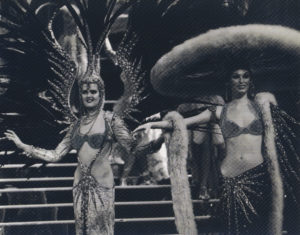
LIVING HISTORY
Chessik laments that the icon can no longer be found at her stage show spectaculars. She has made it her mission to keep the iconic Las Vegas showgirl’s memory alive through a foundation she started in 2006.
The Showgirl Legacy Foundation provides educational presentations in schools, museums, conventions, and other venues. The foundation uses a combination of traveling costume exhibits, historical videos, promotional literature, and original works of art to forward Chessik’s mission.
“While these extravaganzas are gone, the Showgirl Legacy Foundation will keep the sparkle of the iconic showgirl bright for future generations to admire and appreciate,” she says.
While Chessik strives to keep the classic Las Vegas showgirl’s legacy alive, retired showgirl Cari Byers works to keep her modern rendition of the Las Vegas showgirl in the public eye. She has run a local company called Premier Showgirls since 2014.
“Premier Showgirls is a full-service talent agency specializing in traditional Las Vegas showgirls,” explains Byers.
Most of Premier Showgirl’s employees are retired performers from the large production shows. Their clients include trade shows, corporate meetings, and conventions, where they elevate the overall look of events in their flashy costumes and pose for photos with guests.
The Las Vegas showgirl’s world is very small now. She is a shadow of the woman who represented her city for 50 years. Byers hopes for the return of Las Vegas’ classic showgirl stage productions.
